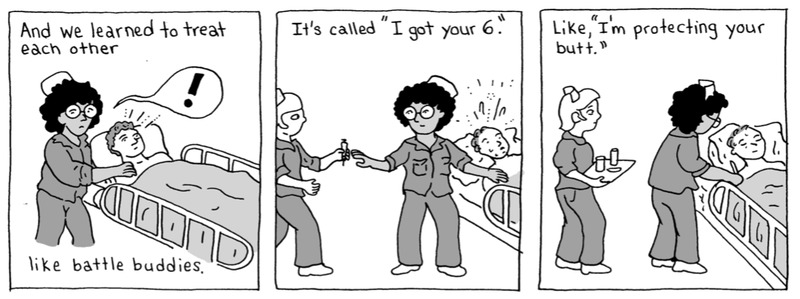"Members of the Church"
Some lesbian veterans reflect on their service when they experienced personal and professional growth, becoming more self-assured in their sexuality and finding community.
Through over a thousand interviews of LGBT veterans for his 1993 book Conduct Unbecoming: Lesbians and Gays in the U.S. Military Vietnam to the Persian Gulf, journalist Randy Shilts gathered that,
“There was inarguably a higher proportion of lesbians among women in the military than in the civilian world. Many lesbians who have served in the armed forces over the past decade estimate that at least twenty percent and perhaps as many as thirty-five percent of military women were homosexual. But these numbers are meager compared with the good old days when as many as 80 percent of WACs were thought to be ‘members of the church.’” (Shilts 1993)
In the chapter “The Women’s War for Inclusion” in Ask and Tell: Gay and Lesbian Veterans Speak Out, historian Steve Estes notes in Fort McLellan, Alabama, the entire chain of command was comprised of women from 1954 all the way until 1978. In some ways, female-dominated military units between WWII and the 1970s could be seen as “sanctuaries of female empowerment and lesbian leadership” (Estes 2007a).
These networks grew their own mythology within certain circles. Most famously, Randy Shilts summarizes the story of a conversation between President Eisenhower and Women’s Army Corps Sergeant Johnnie Phelps.
“WAC Sergeant Johnnie Phelps became legendary or a conversation she had with Eisenhower when she served on the general’s staff during the postwar occupation of Europe. Phelps admired Eisenhower as a soldier’s soldier who genuinely cared for his troops and would never order them to do something he would not do himself. Out of respect for Eisenhower, Phelps would never have lied to him, which was why she knew how to answer the day he called her into his office and said he had reports that there were lesbians in the WAC battalion. He wanted a list of names, he said, so he could get rid of them. That, Phelps suspected, would be a tall order, since she estimated that 95% of the WAC battalion of nine hundred women at that head-quarters was lesbian. ‘Yes, sir,’ Phelps said to the general, according to her later account. She would make the list, if that was the order. Then she reminded Eisenhower that the WAC battalion at his headquarters was one of the most decorated in the Army. It performed superbly, had the fewest unauthorized absences, the least number of venereal-disease cases, and the most infrequent number of pregnancies of any WAC group anywhere. Getting rid of the lesbians would mean losing competent file clerks, typists, and a large share of the headquarters’ key personnel. ‘I’ll make your list,’ Phelps concluded in her crackling North Caroline accent, ‘but you’ve got to know that when you get the list back, my name’s going to be first.’ Eisenhower’s secretary, also in the room, corrected the sergeant. “Sir,” the secretary said, ‘if the General pleases, Sergeant Phelps will have to be second on the list. I’m going to type it. My name will be first.’ According to Phelps, Eisenhower looked at her, looked at the secretary, shook his head, and said, ‘Forget that order. Forget about it.’” (Shilts 1993)
Vietnam-era veterans share stories that provide evidence for the continuation of this sort of solidarity and trust. Throughout her interview, Ms. Reynolds emphasizes the value she placed in support among her “battle buddies.” She and seventeen close friends had the opportunity to move off base to Tokorozawa, “We had a group. Did we have a group!” Decades later, Ms. Reynolds met her current partner, Lesley Watts, while working at the 352nd Combat Support Hospital in Oakland, California. Her friends and coworkers “knew, but they didn’t say a word.” Ms. Reynolds narrated another oral history in 2018 at the Center for Cartoon Studies in White River Junction, Vermont that captures how this idea of mutual support permeated throughout her experience:
"Janice" gave her testimony in the 1990 collection of oral histories, My Country, My Right to Serve, but at the time of the interview, needed to keep her identity anonymous for fear of professional repercussions. When at risk of an investigation into her sexuality, she remembers that "the officer called in was one of the most obvious dykes” but had "taken care of the commander when he had a heart attack." The investigation stopped, and Janice kept her position. She continues,
"As the years rolled on, networking worked real well for me. That's right. Networking. I had friends in the Pentagon. If I was going to another assignment, I'd call up one of my friends and say, "If I go to so-and-so city, who should I be working for?" And they'd say, "Colonel So-and-so, Major So-and-so. 'They'd give me the names. So I knew. And they would tell them if their friends were there"
This critical mass enabled some of these women to experience their sexuality in a way that they had not been able to previously. Anna Gerac said of her relationship with Kathy Reynolds,
"It felt very comforting to have to be in love with someone and to be feeling a different sensation than I had felt with the men in my life and so it was different and yet it felt meaningful and it was comforting because of what we were going through together."
Similarly, Cheryl Marden, Ruth Hughes, and Darlene Greenawalt all met their first same-sex partners in the military. Ms. Hughes told of camping trips where "we would go on just to get away and be with 'our own kind.'" Ms. Greenawalt remembers that having met her "first real lover," Charlie, "Some of the older veteran lesbians had gotten us aside and advised, 'If you want to survive, this is what you need to do' -- make good cover."

